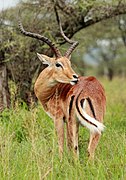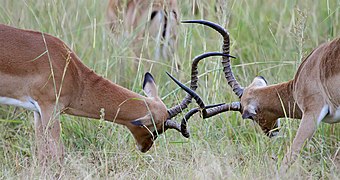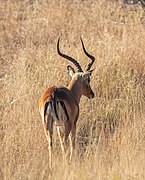Aepyceros melampus
The impala (Aepyceros melampus) is a species of artiodactyl mammal in the Bovidae family. It is a medium-sized antelope. Because of its similar appearance, the impala was previously ranked alongside gazelles. Because of new knowledge, today it is placed in the family of African antelopes.
The word "impala" comes from the Zulu. Its scientific name, Aepyceros melampus, derives from the Greek aipos: tall, keras: horn, melas: black and pus: foot, meaning black feet with high horns.
The Chevrolet Impala car is named after this animal.
Features
This slender animal is famous for its great leaps that can reach more than 10m in length. It achieves a shoulder height of 95 cm and a weight of 40 kg (female) to 65 kg (male).
Above, it is light brown. The belly, chest, neck and chin have a white color. On the hindquarters it has a dark vertical line and a tuft of black hair on the hind legs, above the hooves. The head is graceful, with large eyes and thin, pointed ears. The males are the ones with horns, which can measure up to 90 cm long.
Distribution
Distribution ranges from Kenya and Uganda via Tanzania, Zambia, Mozambique and Zimbabwe to Botswana and in an isolated population in southern Angola and northern Namibia.
Subspecies
Up to six subspecies of impala are known:
- South African PrinterAepyceros melampus melampus).
- Impala de Malaui (Aepyceros melampus johnstonii).
- Impala de Uganda (Aepyceros melampus katangae).
- Black-faced print (Aepyceros melampus petersi).
- Printer of KenyaAepyceros melampus rendilis).
- Impala de Tanzania (Aepyceros melampus suara).
Lifestyle
The impala eats grass, leaves, and seeds. Lives in sparse forests and tree-dotted savannah. Instead of staying in the open, as most grazing antelopes do, this animal runs for cover from any threat.
In times of famine, it is common to see impalas follow troops of baboons to feed on the leaves and fruits that they drop. The elephants are also followed, since when shaking the trees to get their fruits, the pachyderms leave many unpicked and that is when the impala takes advantage to intervene.
During the breeding season, as a rule, a male impala watches over a group of females, pacing back and forth, exposing his horns, ears tucked in and tail raised. The fight of the males for their harem is divided into three combat series.
- First, the challenger shows his clear part of the belly, yawns and pulls out his tongue quickly. Then, as a provocation to combat denies the head.
- In the second phase both rivals, placed in front of each other, the erect heads approach and retire.
- If none of the two of them later give up, embed their horns, push forward and backward, separate and begin again with the last phase until one of the two animals yields.
Fights between impalas do not usually result in injuries.
Females live with their young in herds of ten to one hundred animals. It is common during the calving season to see several calves together with a very small number of females. These groups are known as nursery herds. A few females guard the young while the others graze. Apart from these groups, herds of young and older males also form, which are too weak to defend a territory. Middle-aged males are territorial loners and require each of the females to pass through her territory for himself.
The impala is the animal that sleeps the least in the Animal Kingdom,[citation needed] barely 3 hours is its rest and it usually has a kind of alarm, which It determines, for example, what time you should get up.
Warning signs
To alert their fellow species to the presence of a predator or other danger, impalas use a series of visual, acoustic, and olfactory signals. Visual cues are the best known of these animals. The underside of its tail is immaculate white. When alert, they raise their tails in a series of hops. The white color of this can be seen several meters away, alerting the other animals in the surroundings. The acoustic signals comprise a series of snorts, reminiscent of a rifle shot. When the predator has been identified, these snorts echo throughout the savannah.
Lastly, we have the olfactory cues. These are the lesser known. The glands that impalas carry on their feet release pheromones that indicate the presence of a predator. It is likely that this is the reason why impalas jump giving "kicks" in the air, as if they were in a floating rocking chair. By jumping in this way, they spread the scent throughout the surrounding areas, alerting the herd and other animals to the presence of a predator. This quality may be due to the habit that this antelope has of living in wooded areas and thick vegetation, where visual signals are largely useless.
Top predators
The impala is an antelope that must be on constant alert, as it is a key item on the menu of any large predator in Africa. Their main predators include leopards, cheetahs, wild dogs, hyenas, crocodiles, and pythonids. Lions also frequently hunt impalas, especially during dry seasons, when more substantial prey (wildebeest and zebras) migrate to other areas. The young have not only these predators, but also baboons, jackals, eagles, caracals and ratels. All this makes the impala a fundamental species of its ecosystem.
Direct reciprocity
Impalas belonging to the same social group groom each other with their tongues. The cost of grooming—saliva expenditure and some reduction in predator vigilance—is relatively low. However, the benefit obtained by being neat is considerable, since this behavior serves to eliminate ectoparasites. Since the animals cannot groom each other at the same time, the receivers later return the favor to the senders.
Conservation status
The impala is listed by the IUCN as endangered. The black-faced subspecies (A. m. petersi) is listed as vulnerable, although its population is increasing.
Image gallery
Contenido relacionado
Allium ascalonicum
Dihoplus kirchbergensis
Parthenogenesis







